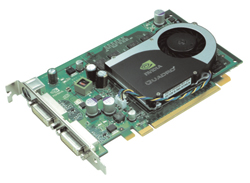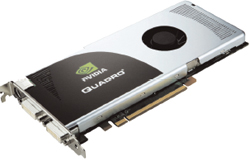New NVIDIA Quadro FX Series Workstation Graphics Cards Deliver HPC for Less
NVIDIA's new FX series of workstation graphics accelerators deliver better performance and more memory at more aggressive prices than ever before.
Latest News
December 4, 2001
By David Cohn
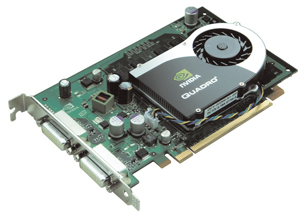 The entry-level NVIDIA Quadro FX 370. |
Over the past year, NVIDIA has once again refreshed its entire lineup of workstation-class graphics accelerators — the Quadro FX series. Previously we looked at the NVIDIA Quadro FX 4600 and FX 5600 boards (see June and July 2007 DE, respectively). Now that the rest of the family has also been updated, it’s time to give you all the details on the entire product line.
Like the ultra high-end Quadro FX 4600 and FX 5600, all of the new graphics accelerators feature NVIDIA’s unified architecture, which dynamically allocates geometry, shading, and pixel processing as well as compute power. Previous generations of graphics cards had separate banks of vertex and pixel shaders that could only be used for accelerating vertex calculations and texturing, respectively. This often resulted in portions of the graphics processing unit (GPU) sitting idle while others were maxed out, because games often use models with low numbers of polygons with lots of textures while CAD models often have large numbers of polygons with few or no textures. The new unified architecture dynamically allocates the GPU’s power between vertex and pixel shading, improving performance for all types of users.
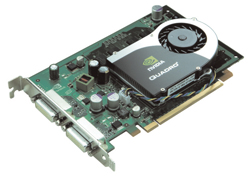 The entry-level 3D NVIDIA Quadro FX 570. |
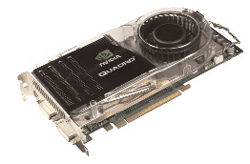 The ultra high-end NVIDIA Quadro FX 4600was reviewed previously. |
|
|
In addition to sharing the same core unified architecture and drivers, the new boards are now Shader Model 4.0 compliant and come with the increased frame buffer capacity needed to make them fully Microsoft Vista ready. The Quadro FX 370, 570, 1700, and 3700 are all based on a 65-nanometer (nm) manufacturing process whereas the FX 4600 and 5600 are 90nm boards. The 370, 570, 1700, and 3700 also support PCI Express version 2.0, which doubles the bus standard’s bandwidth, meaning the X16 graphics slot can transfer 16GBps bidirectionally (8GBps in each direction).
The latest boards also support the new NVIDIA Compute Unified Device Architecture (CUDA) GPU-computing software architecture. Some types of computing tasks have parts that are better suited for CPU computing while other parts are better suited for being run on the GPU. CUDA provides a standard C language interface so that programmers can synchronize hybrid programs running on both CPUs and GPUs.
The New Quadro FX Family
The NVIDIA Quadro FX 370 ($129 MSRP/$115 average street price) is the company’s new low-end entry-level 3D card. Priced $70 less than its predecessor, the board comes with 256MB of DDR2 video memory, twice that of the board it replaces. The 64-bit memory interface yields a memory bandwidth of 6.4GBps. The FX 370 delivers 66 million triangles per second and 2.88 billion texels per second and provides two DVI-I connectors, one of which even supports dual link, enabling the board to support ultra-high resolution displays at 2560 x 1600 at normal refresh rates, a first for an entry-level board. Yet the half-length board uses a single PCIe X16 slot and consumes just 35 watts.
Up a step is the new NVIDIA Quadro FX 570 ($199 MSRP/ $182 street), which outperforms the older FX 550 and FX 560 boards yet costs $80 and $100 less, respectively. Like the new FX 370, the FX 570 comes with 256MB of DDR2 memory, but uses a 128-bit memory interface. This results in a memory bandwidth of 12.8GBps, enabling the board to pump out 137 million triangles per second and a fill rate of 3.68 texels per second. Both of the board’s DVI-I connectors support dual link.
For the mid-range, NVIDIA improves upon the FX 1500 with the introduction of the Quadro FX 1700 ($699 MSRP/$585 street). Likely to become the most popular board in the new Quadro FX lineup, the FX 1700 comes with 512MB of DDR2 memory, again double the amount previously found at this price point. Unlike its predecessor, the FX 1700 uses a 128-bit memory interface, yielding a memory bandwidth of just 12.8GBps, the same as the FX 570. But when coupled with the new GPU, the FX 1700 clearly outperforms its predecessor, delivering 191 million triangles per second and a fill rate of 7.36 billion texels per second. In addition to two dual link DVI-I connectors, the Quadro FX 1700 also provides HD component video.
At the high-end, NVIDIA refreshes its product line with the introduction of the newest member of the family, the Quadro FX 3700 ($1,599 MSRP/$899 street). This board comes with 512MB of GDDR3 memory (double that on the older FX 3500) and uses a 256-bit memory interface to deliver a memory bandwidth of 51.2GBps. The new GPU provides 112 parallel processors, enabling it to deliver 250 million triangles per second and a fill rate of 28 billion texels per second. In addition to its two dual link DVI-I connectors, the board also supports stereoscopic 3D output as well as NVIDIA’s Scalable Link Interface (SLI). SLI technology enables two NVIDIA Quadro FX graphics boards to work in tandem to increase the graphics performance of a single workstation. The FX 3700 requires just a single PCIe X16 slot, but since it consumes 78 watts it does require an auxiliary connection to the system power supply.
The NVIDIA Quadro FX 4600 ($1,999 MSRP/$1,399 street) is technically not a new board. This ultra high-end graphics accelerator was introduced just over a year ago, and was reviewed in the June 2007 issue of DE. But since it is a member of the new Quadro family, we’ll cover it again briefly here. The FX 4600 comes with 768MB of GDDR3 memory and a 384-bit memory interface. Its memory bandwidth is rated at 67.2GBps and the board delivers 250 billion triangles per second and 24 billion texels per second. Like the FX 3700, both of its DVI-I connectors support dual link and the board offers a stereo 3D graphics connector and SLI support. NVIDIA also offers optional G-Sync and SDI option cards for the FX 4600, providing frame lock and broadcast quality video capabilities, respectively. Because it consumes 134 watts of power, the board requires an auxiliary power connection, and with its large cooling fan and plastic cowl protruding more than an inch from the board, it is impossible to use the adjacent expansion slot.
NVIDIA’s Quadro FX 5600 ($2,999 MSRP/$2,573 street) occupies the extreme top end of the product line and, like the FX 4600, Desktop Engineering reviewed this board when it was first introduced nearly a year ago (“Even More Graphics Power,” DE, Aug 2007). Targeted at the interactive display of large, complex models often found in automotive and aerospace design, oil and gas exploration, and scientific visualization, this board doubles the performance of its predecessor. The Quadro FX 5600 comes with 1.5GB of GDDR3 memory and uses a 384-bit memory interface to yield a memory bandwidth of 76.8GBps to deliver 300 million triangles per second and a fill rate of 19.2 billion texels per second.
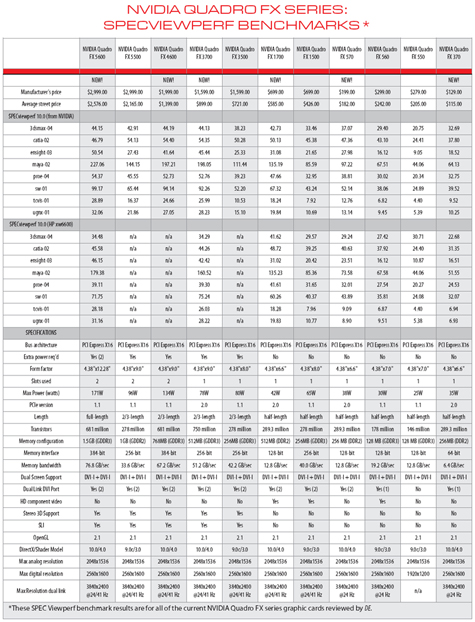 |
Like the FX 4600, the Quadro FX 5600 provides two dual link enabled DVI-I connectors, SLI capability, stereo 3D support and the available G-Sync and SDI option cards. And like the FX 4600, the FX 5600 is so wide that it prevents the use of the adjacent expansion slot. But the NVIDIA Quadro FX 5600 is a full-length board, and its maximum power consumption of 171 watts necessitates the use of not one, but two auxiliary connections to the system power supply.
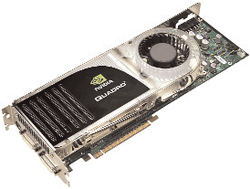 The ultra high-end NVIDIA Quadro FX 5600 outperforms its predecessorby 2X. |
Benchmarking the Boards
As in the past, we tested five of the six boards using the same HP xw6600 workstation equipped with a pair of 3.0GHz Quad-Core Xeon E5450 processors, so all of our results are directly comparable. Desktop Engineering reviewed this system in the April 2008 issue (“Big Power in a Small Package”).
But this is a different system than the HP xw4200 we used in previous years. We switched for two reasons: graphics performance has improved so dramatically that the older system was no longer fast enough to take advantage of the graphics performance and because the xw4200 lacks PCIe 2.0 support. In addition, the HP xw6600 was a close match to the system NVIDIA used to produce the benchmark results shown on its website.
The PCIe 2.0 specification is backward and forward compatible with PCIe v1.x, so newer graphics boards will work in older systems and vice versa. But of course, when installed in an older system (like our original HP xw4200 benchmark platform), the newer boards are limited to the bandwidth of the original PCIe v1.x spec. Similarly, older graphics boards installed in a PCIe 2.0 capable system won’t be able to take advantage of the extra bandwidth.
To help readers compare the benefits of PCIe v2.0, we went back and tested the older NVIDIA boards in the new HP xw6600, using version 10 of the SPEC viewperf benchmark (spec.org). Since we no longer had the FX 3500, FX 4600, or FX 5500 on hand, we were unable to retest those boards. For that reason, our benchmark results chart (see previous page) also includes the results published on the NVIDIA website. We did not see any significant benefit of PCIe 2.0 in our benchmark tests.
What both NVIDIA’s numbers and our own independent tests showed however, is that the new NVIDIA boards clearly outperform the company’s previous generation of graphics accelerators in each product range and, in most cases, the new board in one product range outperformed the older board in the next higher product range. For example, the Quadro FX 570 outperformed the older FX 1500, the FX 1700 outperformed the older FX 3500, and so on.
All of the new NVIDIA Quadro FX boards are fully certified with most CAD and DCC (digital content creation) applications and all of the boards in the Quadro FX line, including earlier boards, use the same unified video driver. Drivers are available for most 32- and 64-bit operating systems, including Vista, XP, and Linux.
Many of NVIDIA’s older Quadro FX boards remain available, but with the new boards outperforming the older boards at similar or sometimes even lesser price points, we recommend going with the newer products. With these six boards to choose from, there’s definitely a NVIDIA Quadro FX graphics accelerator for every CAD user.
More Info:
NVIDIA Corporation
Santa Clara, CA
NVIDIA Quadro FX 370
> Price: $129 (suggested retail), $115 (average street)
NVIDIA Quadro FX 570
> Price: $199 (suggested retail), $182 (average street)
NVIDIA Quadro FX 1700
> Price: $699 (suggested retail), $585 (average street)
NVIDIA Quadro FX 3700
> Price: $1599 (suggested retail), $899 (average street)
NVIDIA Quadro FX 4600
> Price: $1995 (suggested retail), $1399 (average street)
NVIDIA Quadro FX 5600
> Price: $2999 (suggested retail), $2576 (average street)
Contributing Editor David Cohn is a computer consultant and technical writer based in Bellingham, WA, and has been benchmarking PCs since 1984. He’s an applications engineer with The PPI Group, and the author of more than a dozen books. Please send comments about this article to [email protected]. You can also contact David at [email protected].
Subscribe to our FREE magazine, FREE email newsletters or both!
Latest News
About the Author
David Cohn is a consultant and technical writer based in Bellingham, WA, and has been benchmarking PCs since 1984. He is a Contributing Editor to Digital Engineering, the former senior content manager at 4D Technologies, and the author of more than a dozen books. Email at [email protected] or visit his website at www.dscohn.com.
Follow DE






